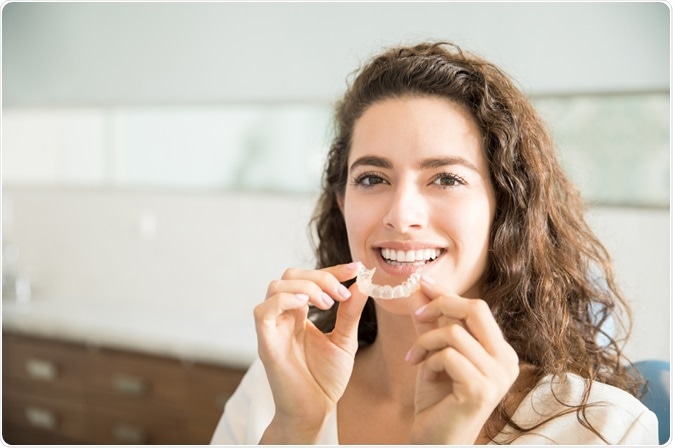An upsurge in the demand for dental aesthetics has led to the evolution of dental appliances like clear aligners. Clear aligners aid in aligning teeth in an appropriate shape within the dental arch.
Over the past few years, clear aligners have gained importance as they appear more aesthetic, comfortable, and handy. However, clear aligners pose some side effects.

Image Credit: antoniodiaz/Shutterstock.com
How clear aligners help in aligning the teeth?’
The principal mechanism via which clear aligners work is similar to dental braces wherein teeth are slowly moved over some time. An orthodontist usually plans the treatment via obtaining various records like X-rays, photographs, and dental impressions.
Post analyzing these records treatment is planned to achieve the desired tooth movement. At the end of the treatment, the aim is to achieve well-aligned teeth thus allowing proper closure of upper and lower teeth upon mastication.
Tooth alignment is an intricate biological process where regular monitoring is imperative by the dentist.
Tooth aligners are the plastic imitation of teeth. They work by creating a mild pressure on teeth and slowly push the teeth in the desired position. Orthodontists recommend wearing clear aligners for at least 22 hours a day.
Clear aligners must be replaced at regular intervals; however, it is done at the discretion of a dentist. In general, an old set is replaced by a new one after two to three weeks to further reposition the teeth. The dentist will keep on replacing old aligners with new once until the desired results are achieved.
What are the benefits and drawbacks of clear aligners?
Tooth aligners are handy orthodontic appliances that can be easily removed during eating, brushing, and tooth flossing process which makes them more viable during routine dental regimens.
However, one major drawback of aligners is that they cannot be replaced with orthodontic braces during complex orthodontic treatments.
Aligners adhere to the tooth surface via tooth-colored attachments that are placed on the surface of the teeth; however, tooth aligners are susceptible to discoloration once they come in contact with liquids.
Flavored water, energy drinks, fruit juices, drinks containing soda, or highly sugary or acidic drinks are some drinks that should be completely avoided. These liquids can easily penetrate through aligners and stay on its surface for a longer period which can lead to discoloration of aligners and even teeth.
As a thumb rule, it is best to avoid drinks that have a pH below 7.0. Also, brushing the teeth with fluoridated toothpaste can protect teeth during treatment with aligners.
Unlike fixed braces, aligners can be removed anytime, and patients can remove them often which will not result in the desired tooth movement. Aligners can easily become a source of various infections if they are placed in unhygienic conditions post removal. Placing them on dirty places like unclean surfaces, napkins, or in pockets should be completely avoided.

Image Credit: Marian Weyo/Shutterstock.com
What are the adverse effects of clear aligners?
Several studies have been conducted over the past few years to assess the adverse effects of aligners on oral health. One such retrospective analysis was done on the safety of aligners. The data was collected from November 2006 to November 2016.
This data was analyzed, and it revealed serious adverse events. Below is the list of side effects in the order of descending frequency:
- Breathing difficulty-Placement of aligners can hamper the normal breathing process and one may feel suffocated after wearing them
- Sore throat and tongue- Soon after wearing aligners one may experience a sore throat. This can hamper in swallowing which may further result in other health complications
- Itchiness and hives-Tooth aligners can irritate oral mucosa and may result in extreme itchiness and breakouts
- Severe hypersensitivity reactions- Many times aligners may be rejected by the body’s natural response to a foreign body. This may lead to severe hypersensitivity reactions referred to as anaphylaxis.
- Swelling in the lips – Aligners may exert pressure on the lips and hence may cause inflamed lips
- Other concerns like restricted airway, pain in the chest, and cough were also reported during the analysis
- At times wearing aligners may cause nausea, painful ingestion of food, dryness of mouth, and headaches
- Rarely swelling of eyes is also reported with the usage of aligners. Aligners may also cause breakouts on the lips
- Few patients may also report fatigue, soreness, and breakouts on the tongue.
- Aligners may also put an excessive pressure on the gums thereby resulting in gums problems like swelling and bleeding
Aligners worn over an extended period can severely affect gum health thereby resulting in concerns like periodontitis and gingivitis. One study done on aligners reported that aligners may lead to the weakening of tooth roots which may cause slow resorption of the dental roots over some time.
Further Reading